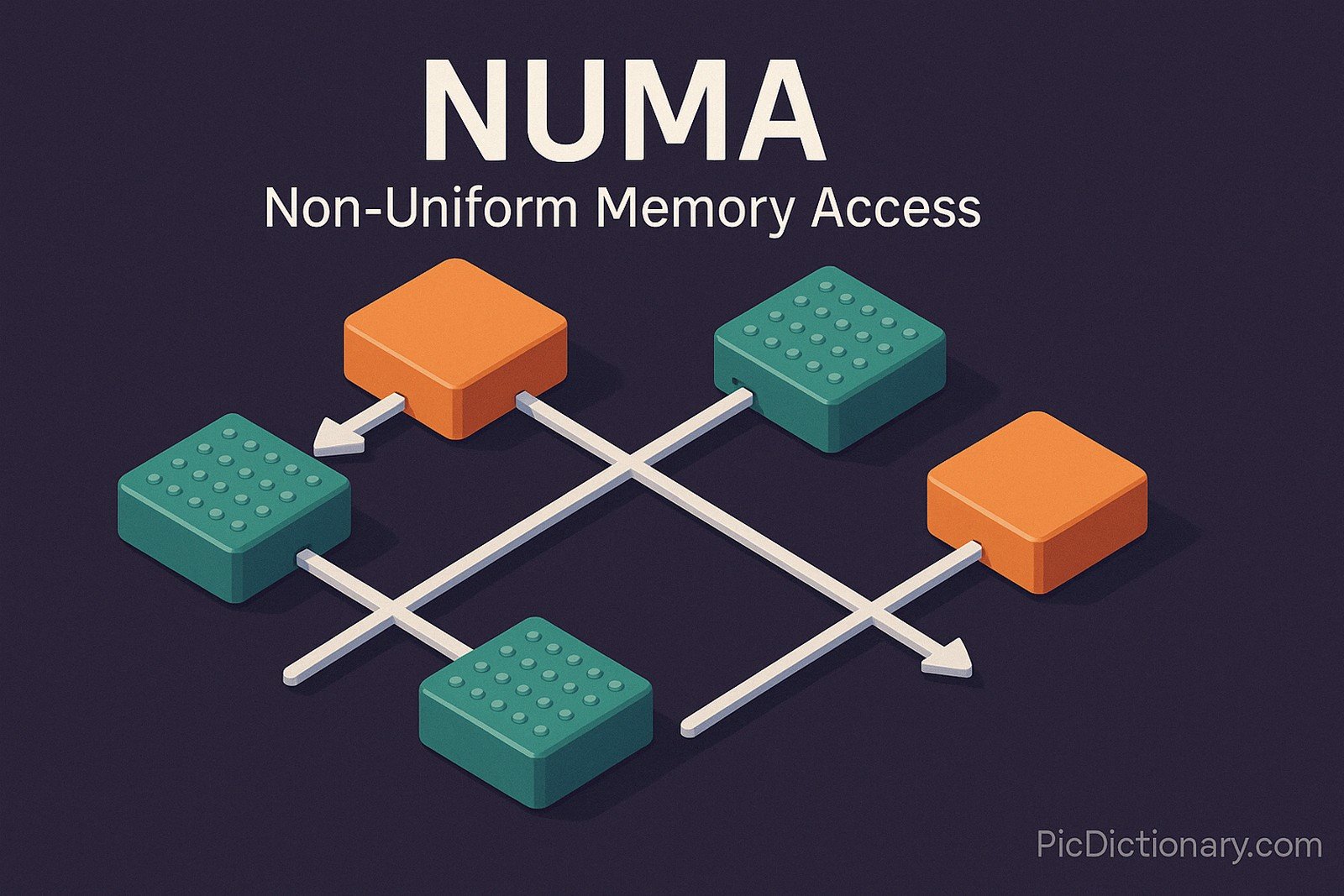NUMA (Non-Uniform Memory Access)

Quick Navigation:
- NUMA Definition
- NUMA Explained Easy
- NUMA Origin
- NUMA Etymology
- NUMA Usage Trends
- NUMA Usage
- NUMA Examples in Context
- NUMA FAQ
- NUMA Related Words
NUMA Definition
Non-Uniform Memory Access (NUMA) is a computer memory design used in multiprocessor systems, where the memory access time depends on the memory location relative to the processor. In NUMA, each processor has its local memory, and accessing this local memory is faster than accessing memory local to another processor. This design helps in optimizing the performance of multi-core and multi-CPU systems by reducing bottlenecks and improving memory bandwidth utilization. NUMA architectures are commonly found in high-performance servers, database systems, and data-intensive computing environments.
NUMA Explained Easy
Imagine having a toy box right next to you and another toy box across the room. If you need a toy, it's faster and easier to grab one from the box next to you than to walk across the room. In NUMA, each processor has its “toy box” of memory close by, making it quick to access. If the processor needs something from another “toy box,” it takes longer. This setup helps computers work faster by making smart decisions about where to get memory from.
NUMA Origin
NUMA originated as a solution to overcome scalability problems in traditional symmetric multiprocessing (SMP) systems. First introduced in the 1990s, NUMA allowed processors to efficiently scale with more memory and cores without facing severe performance degradation. Early implementations were seen in systems by companies like SGI and Sequent, and the concept has since been refined and integrated into modern servers and workstations.
NUMA Etymology
The term "NUMA" refers to memory access that is not uniform across the system; processors have differing access times to different parts of memory, depending on locality.
NUMA Usage Trends
NUMA has become increasingly important in recent years with the growth of multi-core processors and large-scale computing needs. Modern operating systems, virtualization platforms, and high-end servers are built with NUMA-awareness to ensure optimal performance. Cloud computing environments, big data analytics, and large database systems also rely heavily on NUMA architectures for processing massive workloads efficiently.
NUMA Usage
- Formal/Technical Tagging:
- Computer Architecture
- Memory Management
- High-Performance Computing - Typical Collocations:
- "NUMA-aware application"
- "NUMA node balancing"
- "optimize for NUMA architecture"
- "NUMA latency issues"
NUMA Examples in Context
- High-performance servers use NUMA to reduce memory latency and enhance parallel processing.
- Database systems are optimized to allocate memory near the processor executing the query in NUMA-based servers.
- Cloud platforms implement NUMA-awareness to prevent performance bottlenecks in virtual machines.
NUMA FAQ
- What is NUMA in computing?
NUMA is a memory architecture where each processor has its own local memory, and access times vary depending on proximity. - How does NUMA improve system performance?
By reducing memory access contention and allowing faster access to local memory, NUMA enhances parallel processing efficiency. - Where is NUMA typically used?
NUMA is used in servers, databases, virtualization platforms, and high-performance computing environments. - What challenges does NUMA present?
NUMA requires specialized OS and application support to manage memory locality and avoid performance bottlenecks. - Is NUMA supported by operating systems?
Yes, most modern operating systems like Linux and Windows Server support NUMA architectures. - How is NUMA different from SMP?
In SMP, memory access time is uniform across processors, while NUMA access time depends on locality. - What are NUMA nodes?
NUMA nodes are groups of processors and their associated local memory in a NUMA system. - Can NUMA configurations be manually adjusted?
Yes, advanced users can tune NUMA configurations and memory allocation policies for optimal performance. - Why do databases benefit from NUMA?
Databases can allocate memory closer to processing threads, reducing access time and improving throughput. - What happens if NUMA is not managed properly?
Improper NUMA management can lead to latency, performance degradation, and inefficient resource utilization.

NUMA Related Words
- Categories/Topics:
- Computer Architecture
- Server Optimization
- Parallel Computing
Did you know?
In 2015, researchers demonstrated that improper NUMA configuration in cloud servers could lead to up to a 40% decrease in performance, highlighting how critical it is for systems and applications to be NUMA-aware.
PicDictionary.com is an online dictionary in pictures. If you have questions or suggestions, please reach out to us on WhatsApp or Twitter.Authors | Arjun Vishnu | @ArjunAndVishnu

I am Vishnu. I like AI, Linux, Single Board Computers, and Cloud Computing. I create the web & video content, and I also write for popular websites.
My younger brother, Arjun handles image & video editing. Together, we run a YouTube Channel that's focused on reviewing gadgets and explaining technology.



Comments powered by CComment